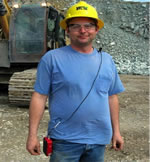 |
| Shane Mashburn, Pittsboro Plant, North Carolina. |
Luck Stone takes its potential impact on the community seriously, and to that end, takes the time to discuss the methods it uses to minimize noise. There are compliance standards created by the Mine Safety and Health Administration (MSHA), but we also have internal standards to help ensure that our associates are protecting their hearing.
All of the hearing standards are set according to the decibels of exposure and the amount of time that a person would be exposed at that level. The MSHA law states that a miner cannot be exposed at any time to a noise that is louder than 115 dB, nor can an eight hour average exceed 90 dB. As a comparison, 90 dB represents the sound of a man shouting very loudly, or a police whistle. Exposure to noises above 90 dB for more than eight hours can lead to permanent hearing loss.
At Luck Stone, our associates are enrolled in a Hearing Conservation Plan and receive training every year. Hearing protection such as ear plugs and ear muffs are provided, and insulation has been added to some equipment that is typically the loudest. Associates are tested every year so that they can compare results from year to year, and identify potential problems before they become worse.
Another tactic to recognize noise hazards is for associates to wear noise dosimeters during a typical day, and determine whether they have been exposed to loud noises.
 What are some of the tasks in our plant that cause some of the loudest noises? Motors and crushers can be loud, truck engines, places where metal might hit against metal, hammers that are hit against metal, and even loud power tools and landscape tools. Any time a miner is placed near one of these loud locations there is an opportunity to decide what the best form of hearing protection might be.
What are some of the tasks in our plant that cause some of the loudest noises? Motors and crushers can be loud, truck engines, places where metal might hit against metal, hammers that are hit against metal, and even loud power tools and landscape tools. Any time a miner is placed near one of these loud locations there is an opportunity to decide what the best form of hearing protection might be.
We must also consider the potential exposure of customers, vendors and contractors who come on site. As they sign in, they are asked to pay attention to site-specific training especially as related to mine hazards, such as noise. Personal Protection Equipment (PPE) is always necessary. Visitors are required to borrow any PPE thats needed in order to have a safe visit.
Finally, we try to limit the noise that extends beyond our property boundary so that we are not exposing our neighbors to disruptive sounds. Noise can be muffled by earthen berms that surround the property, vegetation in the buffers, or strategic placement of louder equipment down in the quarry pit. Certain quarry operations can be enclosed in a building where the walls help to limit the escape of noise. Recently, we have changed many of our backup alarms on trucks to a low-frequency buzzing rather than the familiar high-pitched beeping, and the buzzing is much less noticeable.
It’s true that quarries have the potential to be very noisy places, but Luck Stone is constantly monitoring the equipment, the people and the surrounding environment in order to reduce our impacts as much as possible. Once again, our customers and our neighbors are the key to our success, and we are committed to do whatever it takes to create a safe and healthy environment for all.
Mark Williams is the environmental manager at Luck Stone.

